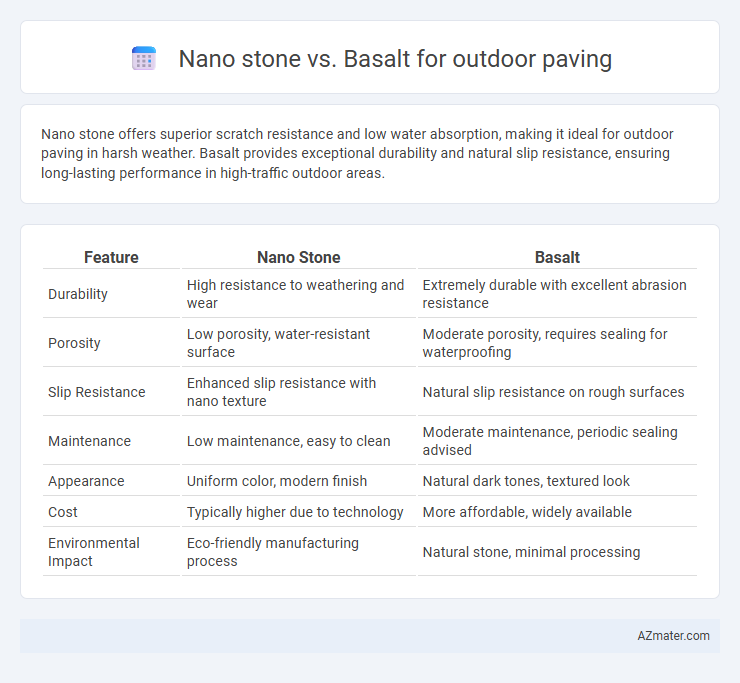Nano stone offers superior scratch resistance and low water absorption, making it ideal for outdoor paving in harsh weather. Basalt provides exceptional durability and natural slip resistance, ensuring long-lasting performance in high-traffic outdoor areas.
Table of Comparison
| Feature | Nano Stone | Basalt |
|---|---|---|
| Durability | High resistance to weathering and wear | Extremely durable with excellent abrasion resistance |
| Porosity | Low porosity, water-resistant surface | Moderate porosity, requires sealing for waterproofing |
| Slip Resistance | Enhanced slip resistance with nano texture | Natural slip resistance on rough surfaces |
| Maintenance | Low maintenance, easy to clean | Moderate maintenance, periodic sealing advised |
| Appearance | Uniform color, modern finish | Natural dark tones, textured look |
| Cost | Typically higher due to technology | More affordable, widely available |
| Environmental Impact | Eco-friendly manufacturing process | Natural stone, minimal processing |
Introduction to Nano Stone and Basalt
Nano stone offers exceptional durability and a lightweight structure, making it an innovative choice for outdoor paving. Basalt, a natural volcanic rock, is known for its high density and resistance to weathering, providing long-lasting strength in exterior applications. Both materials excel in durability, but nano stone emphasizes modern engineering for enhanced performance while basalt relies on natural robustness.
Composition and Properties Comparison
Nano stone, composed primarily of engineered composite materials with nano-enhanced resin binders, offers exceptional durability and resistance to scratches and stains, making it ideal for outdoor paving. Basalt, a natural volcanic rock rich in iron and magnesium silicates, provides high compressive strength and excellent weather resistance due to its dense, fine-grained crystalline structure. While nano stone features superior uniformity and enhanced surface hardness from nano-scale additives, basalt excels in natural thermal stability and slip resistance, balancing performance with aesthetic appeal in outdoor environments.
Durability in Outdoor Environments
Nano stone offers exceptional durability in outdoor environments due to its engineered composition that resists weathering, UV exposure, and abrasion. Basalt, a dense volcanic rock, naturally withstands extreme temperatures, moisture, and heavy foot traffic without significant wear or cracking. Both materials excel in longevity for outdoor paving, but basalt's natural toughness provides superior resistance to environmental stressors over prolonged periods.
Slip Resistance and Safety
Nano stone offers superior slip resistance for outdoor paving due to its ultra-fine texture, significantly reducing the risk of slips in wet conditions. Basalt, known for its natural roughness and durability, provides excellent traction but may become slippery when polished or worn smooth. Prioritizing safety, nano stone's advanced surface properties make it a more reliable choice for high-traffic, moisture-prone outdoor areas.
Aesthetic Appeal and Design Options
Nano stone offers a sleek, uniform appearance with vibrant colors and a smooth texture, ideal for contemporary outdoor paving designs. Basalt provides a natural, rugged look with varied shades of dark gray and black, enhancing rustic or industrial aesthetics. Both materials support diverse design options, but nano stone's precision cutting allows for intricate patterns, while basalt's organic variations create unique, earthy visual interest.
Cost Comparison and Value for Money
Nano stone offers a lower initial cost compared to basalt, making it an attractive option for budget-conscious outdoor paving projects. Basalt, although more expensive upfront, provides superior durability and weather resistance, leading to lower maintenance expenses over time. Considering long-term value for money, basalt's longevity and resilience often justify its higher price in climates with heavy wear and exposure.
Installation Process and Maintenance Needs
Nano stone offers a lightweight and flexible installation process compared to basalt, which is denser and requires heavy-duty equipment for precise placement. Maintenance of nano stone involves easy cleaning with mild detergents and minimal sealing, whereas basalt demands periodic sealing and grout repairs to prevent moss growth and surface erosion. The rapid curing time of nano stone reduces project duration, while basalt's durability ensures long-term resistance under heavy foot traffic but necessitates more upkeep.
Weather Resistance and Longevity
Nano stone offers excellent weather resistance for outdoor paving, resisting staining, UV rays, and frost damage better than many natural stones, including basalt. Basalt is a dense volcanic rock known for its durability and natural resistance to wear, but it can be prone to slight weathering and erosion over time in harsh climates. Nano stone's engineered composition provides enhanced longevity by minimizing porosity and surface degradation, making it ideal for high-traffic outdoor spaces with extreme weather exposure.
Environmental Impact and Sustainability
Nano stone offers a low environmental footprint due to its energy-efficient production process and minimal material waste, making it a sustainable choice for outdoor paving. Basalt is a natural volcanic rock renowned for its durability and natural thermal regulation capabilities, contributing to reduced urban heat island effects. Both materials provide eco-friendly options, but basalt's natural origin and longevity enhance its role in sustainable outdoor paving projects.
Choosing the Right Material for Outdoor Paving
Nano stone offers a lightweight, durable option with high resistance to scratches and stains, making it ideal for high-traffic outdoor paving areas. Basalt boasts natural strength, weather resistance, and a unique dark aesthetic preferred for garden paths and patios. Selecting the right material depends on balancing durability, maintenance requirements, and desired visual appeal to ensure longevity and performance outdoors.

Infographic: Nano stone vs Basalt for Outdoor Paving
 azmater.com
azmater.com